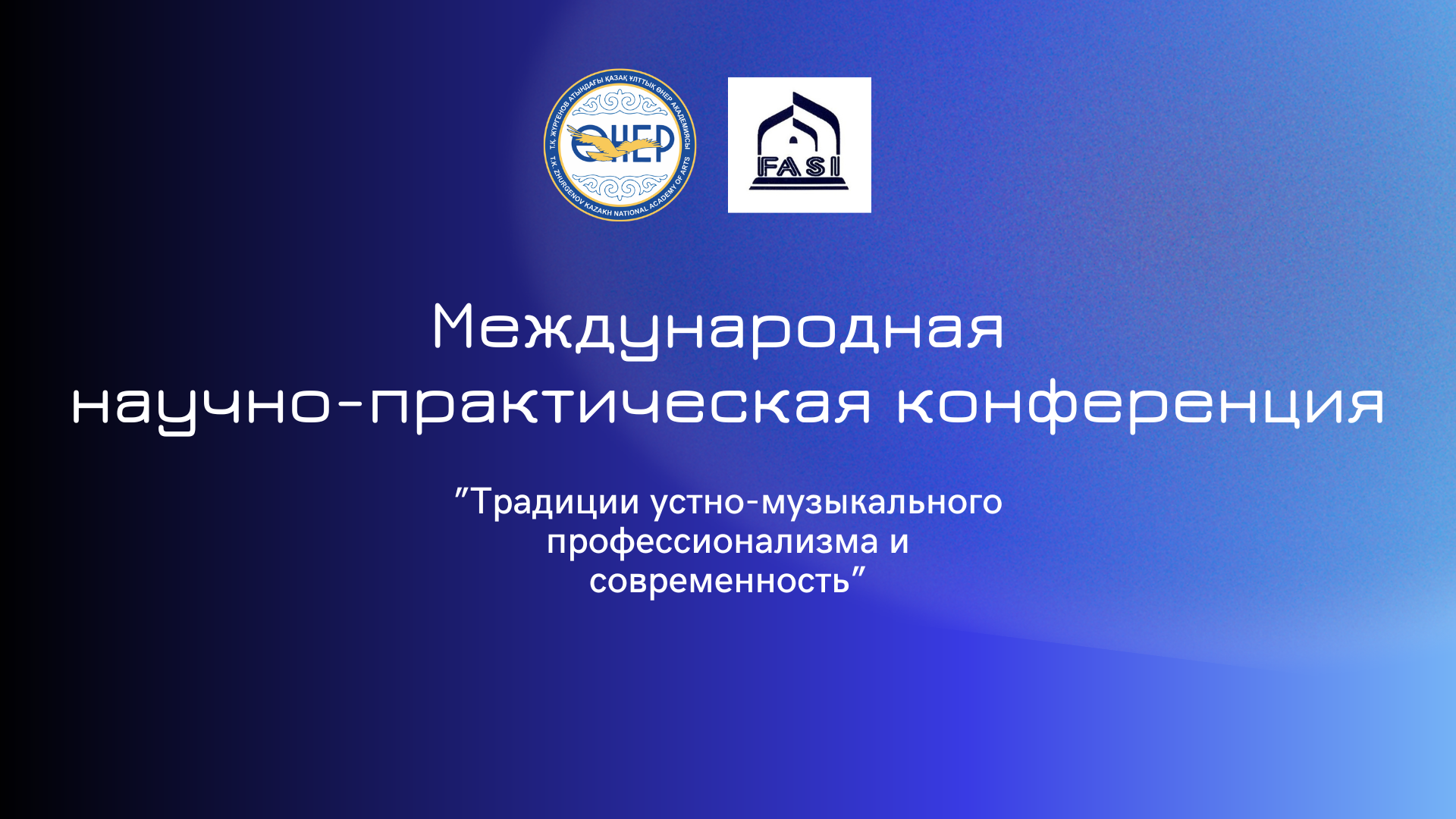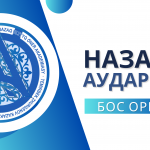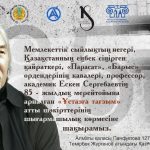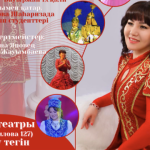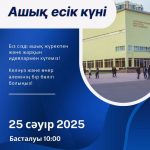Republican government agency “T. K. Zhurgenov Kazakh National Academy of Arts” of the Committee of Culture of the Ministry of Culture and Sport of the Republic of Kazakhstan
INFORMATION LETTER
Dear friends and colleagues!
In October (from 12 to 14), 2022, T. K. Zhurgenov Kazakh National Academy of Arts (Almaty, Kazakhstan) hosts a Festival of traditional music of the peoples of Central Asia and an international scientific and practical conference “Traditions of oral musical professionalism and modernity” dedicated to the 80th anniversary of the Doctor of Art History, Professor A. I. Mukhambetova.
- Organizers: Academic-Editorial Department, Department of Traditional Musical Art of the T. K. Zhurgenov Kazakh National Academy of Arts and Department of Musical Art of the Institute of Art Studies of the Academy of Sciences of Uzbekistan (Tashkent).
- Address of the organizing committee: 050000, Republic of Kazakhstan, Almaty, 127 Panfilov str., office 26.
- Phone: +7 7707 255-00-35 (WhatsApp); +7 (727) 272-04-99
- Email: ogulzada@mail.ru
- Official website: https://kaznai.kz/
- Instagram: @zhurgenov.science
The focus of the conference will be on the preservation and development of traditional musical cultures at the present stage of global processes. These issues require not only discussion, but also formulation, solution of specific tasks in the field of performance and training of traditional musicians. The future fate of the cultural heritage of the peoples of Central Asia depends on how the problems of modern functioning and education of carriers (performers) of traditional music are currently being solved.
Scientists who develop issues of performing and teaching traditional musicians, teachers (Ustaz, Ustod) of various musical institutions with experience, theoretical and practical developments in the field of methods of professional and mass music education in Central Asian countries are invited to participate in the conference. Within the framework of the Festival of Traditional Music, master classes are supposed to be held in order to demonstrate certain traditional methods and methods of teaching in the field of oral musical professionalism, as well as in the field of practical forms of work with students in modern educational organizations. The focus of the conference will be on the discussion of national issues in art.
The priority areas of the conference are:
- – globalization and practical issues of preservation of intangible cultural heritage (traditional music);
- – Ethnomusicology and ethnomusicology schools of Central Asia;
- – traditional performance, composing and performing schools in the oral professional cultures of the East;
- – forms of performance, modern functioning of traditional music and its carriers in the cultures of Central Asia;
- – broadcasting of musical heritage and systems of traditional and modern music education in Central Asian countries;
- – methods of teaching in the oral and musical art (folk singing, instruments, epos, etc.) and their use in the field of professional and mass musical education;
- – ethno solfeggio and other musical-theoretical disciplines in the system of professional musical education of traditional musicians.
We will plan to publish proceedings materials (it is free for authors). A printed version will be available for a fee.
The conference will be held in a mixed format (offline and online). Upon special request, it is possible to officially inviting participants to the academy at the expense of the sending party.
To participate in the conference, it is necessary to submit an application and abstracts of the report by e-mail before September 5, 2022 inclusive ogulzada@mail.ru . The organizers of the conference reserve the right to select applications and abstracts. If the applications and abstracts meet the requirements, the organizers will contact the applicants by September 7 to send the full texts of the reports by September 10, 2022 for the publication of the collection of materials.
Conference working languages: Kazakh, Russian, English
Time limit for presentations: no more than 15 minutes (+ 5 minutes discussion).
Appendix 1. Application form.
Application for participation in the academic conference “Traditions of oral musical professionalism and modernity” of the T. K. Zhurgenov Kazakh National Academy of Arts
| Surname, name (written in full as in the passport or identity document) | |
| Place of work / place of study (full name of the institution without abbreviations) | |
| Position / course and department for students | |
| Academic degree, academic title, honorary title (if any) | |
| Contact numbers (Telegram, WhatsApp) | |
| Postal address (with zip code) | |
| Topic of the report and / or article (without quotes) | |
| Making a presentation (yes/no) | |
| Participation online/offline (insert as appropriate) |
Appendix 2. Requirements for articles.
The Organizing Committee accepts only original, previously unpublished scientific articles prepared taking into account generally accepted scientific and ethical standards. The content of the article should correspond to the topic of the conference, one of the main directions, headings or sections.
ARTICLES DESIGNED WITHOUT TAKING INTO ACCOUNT THE FOLLOWING REQUIREMENTS ARE NOT ACCEPTED FOR PUBLICATION!
The organizing committee is provided with:
1. Application for participation in the conference with an abstract of the article
2. The author’s original of the article in electronic format in the MS Word extension (Example of the title of the article: Asylbekov/Petrov Article).
MANDATORY TEXT PARAMETERS
- • Font: Times New Roman
- • Size: 14 pt
- • Line spacing: 1.0 (without spacing between paragraphs of the same style).
- • The volume of the article: 15-25 thousand characters with spaces (excluding annotations, keywords, notes, list of sources).
Text structure:
• 1. UDC index, revealing the thematic content of the article (in the upper left corner in bold).
• 2. Information about the author/authors (in italics in the center) — full name, academic degree, academic title, position, place of work (study), including the department (if available), ORCID, email address. The text is provided in Kazakh, Russian and English.
• Students, undergraduates, doctoral students and postgraduates indicate all the data of the supervisor: full name, academic degree, academic title, position, organization. The text is provided in Kazakh, Russian and English.
• 3. The title of the article (in bold CAPITAL letters in the center). The text is provided in Kazakh, Russian and English.
• 4. Abstract: summary of the article according to the following structure: the relevance of the problems and novelty, the main content aspects, research methods, results. Volume: at least 100 words. It is placed separated by a space after the title of the article. Text alignment by width. The text is provided in Kazakh, Russian and English.
• 5. Keywords for the content of the abstract and article (8-10 words). Placed after the annotation. Alignment of the main text to the width. The text is provided in Kazakh, Russian and English.
• 6. The main text of the article should preferably be divided into subsections (introduction, literature review, main part, research results). Alignment of the main text to the width.
• 7. List of sources/literature. Text alignment by width.
Initials in the text are typed through an INDISSOLUBLE SPACE with the surname (simultaneous pressing of the keys “Ctrl” + “Shift” + “space”). Example: T. K. Zhurgenov. Not allowed: T.K.Zhurgenov
The quotation marks “…” are used in the text. If there are internal and external quotation marks, then the external ones are «Christmas trees», the internal ones are “paws”: «…”…”».
The text uses a long dash (—), obtained by simultaneously pressing the keys “Ctrl” + “Alt” + “-” (on the numeric keypad), as well as a hyphen (-).
Automatic numbering is not used in lists and enumeration.
Infographics, including tables, diagrams, figures and formulas in the text should be numbered; diagrams and tables should have headings placed above the diagram or table field, and each figure should have a caption.
The list of sources (from 7 to 15 titles) is drawn up in the form of cross-text bibliographic references in accordance with the accepted GOST, is placed at the end of the article. The city of the publication is prescribed in full, including Moscow, St. Petersburg, etc.
Some examples:
Books:
Sats N. I. Children come to the theater. — Moscow: Iskusstvo, 1961. — 312 p.
Magazines, newspapers:
Smetova, A. A., Mukasheva, A. B. Formation and development of conducting and choral education in Kazakhstan // Bulletin of KazNU. The series “Pedagogical sciences”. — 2015. — №1 (44). — pp. 4-10.
Collections of articles and conferences:
Marchenkova A., Marchenkov A. Artistic image in choreographic art // Actual tasks of pedagogy: materials of the III International Scientific Conference. — Chita: Young Scientist, 2013. — pp. 25-32.
Electronic resources:
Podkorytova M. O. Behind the scenes of Cirque Eloize. How to create a show about love [Electronic resource] // The official website of the online edition Uralweb.ru / URL: http://www.uralweb.ru/pages/provereno/6462.html (Date of reference: 04/19/17).
- Sources are given in the order of mention/citation in the article. References to the list in the main text are given in square brackets [source number in the list, page] (for example, [8, p. 10-15; 9, p. 128]).
- If it is necessary to re-quote the source, the reference is given to the number of the first mention of the source. Repeated and complex links are not used. The titles (and journal titles) in the second and subsequent links cannot be replaced with their verbal equivalents ” Ibid “, “There”, etc.
- When making a list of sources, automatic numbering of the text editor is not used, the ordinal number is separated from the link text by a tab sign. All bibliographic references to electronic resources must indicate the date of reference. It is preferable to refer to scientific, special or fiction literature in printed form.
- When quoting Internet resources, it is necessary to indicate as fully as possible the full name of the author(s), the exact title of the work, the name of the resource that published the described document, as well as the exact link to the original web page (and not to the main page of the site from which the material was taken), the date of the appeal, etc.
The authors of the articles are responsible for the content of the articles and for the fact of their possible publication. The Organizing Committee is not responsible for the inaccuracy of the published data, and also does not bear any responsibility to the authors and/or third parties and organizations for possible damage caused by the publication of the article.


